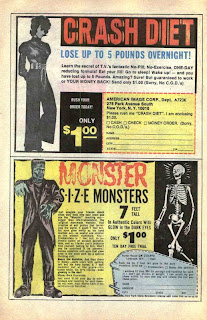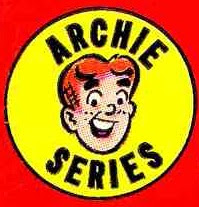Yep, just when you thought it was safe to visit the
Diversions, Ol' Groove has come up with yet another department:
BURNING QUESTION. For our inaugural post, I have to know:
were comics
really just for kids during the Groovy Age? I know the spinner rack called out, "Hey, Kids! Comics!" for many a decade. During the 80s, DC proudly trumpeted "Comics aren't just for kids anymore!" And at least 98% of the U.S. population just
knew comics were kid stuff. But when I look through the Winter 1972/1973 ads of some of the major comicbook publishers, it sure seems that the advertisers didn't believe comics were "just for kids"! How many age groups--er--demographics do you see represented in the following samples...?
 |
| Mildew! What do you expect me to do about mildew? |
|
|




























































While I'm no expert on the subject, I think that comics, while mainly marketed towards kids, did also appeal to many different age brackets and demographics. I seem to recall reading about how comic strips in newspapers were something that parents would read when they got the paper, then give to their kids when they got home.
ReplyDeleteAnd Stan Lee himself has said that when he was writing FF and Spider-Man that they were getting more and more letters from high school and college students, as well as adults. While mainly presented in a format suitable for children, I'd imagine a lot of the themes of tragic heroes and the deep characterization were appealing to older audiences.
And let's face it, it's easier to get a broad range of people consuming a form of media if it's accessible to both children and adults. If you look at popular films, such as anything Disney puts out, Hunger Games, or the Marvel movies, you'll see that they were based on source material that are generally perceived as being for children or young adults. But they're massive blockbusters. If an elementary school kid can read a comic, then so can an adult, so it would make sense that people older than, say, 8-10 would have read them.
My impression has always been that Silver Age Marvel comics appealed to a slightly older audience than most of their competitors. I would say a typical DC fan in 1966 was 7-12 years old, and a typical Marvel fan was 12-15. (Obviously, there are exceptions to both rules.) After 1970, DC began emulating Marvel (tragic heroes, deep characterization), so they were both aiming at the same audience.
DeleteI think advertisers assumed that older siblings and parents would thumb through junior's comics from time to time to see what he was reading and have their attention caught by the ads.
ReplyDeleteBoth excellent answers that (of course!) explain Marvel and DC's (and maybe some of Charlton's) thinking--but what about all those Hanna-Barbera Charltons, the kiddy Gold Key, and the "tweener" Archie mags? Kid's answer probably fits there, but still...
ReplyDeleteC'mon, Gang! Have some fun with this one. Put your tongue in your cheek if you have to (that's what I did when I wrote the post! ;D )
Ads in comics prior to about the mid-1980s are absolutely fascinating to me.
ReplyDeleteOtherwise, I have to question Kid's observation about advertisers assuming that parents and older siblings would pick up and flip through a comic. I think you have to look at what kind of advertisements were being aimed at these older age brackets: they usually have to do with self-esteem issues (e.g. products for weight loss or gain [those "gain weight in the right places" ads aimed at women are especially odd from today's standpoint], hair growth, etc.) or vocational training. I don't know if these advertisers had actually done the market research, but one may assume that they were pretty sure significant numbers of socially awkward and/or unemployed (or unhappily employed) adults in their 20s/30s were regularly reading comics.
Well ... ideally, comics would appeal to both kids and adults. Many of the great Bronze Age titles could be read with satisfaction by both. Sadly, today, comics are fit for neither....
ReplyDeleteI think comics were mainly marketed toward kids in the 1960's and 1970's, but the publishers and advertisers realized that some teenagers and adults would read them. There may have been a widespread assumption back then that any adults who read comics were relatively uneducated and unskilled. That would explain the ads for GED courses and vocational training. The ads for toys and games were obviously for preteens, and the ads for body building and martial arts training were aimed at nerdy tweens who were being bullied.
ReplyDeleteSorry to spoil the fun but it isn't it more likely that many of these advertisers were offered comparatively cheap page rates - maybe as part of bulk discount packages that crossed a whole range of publishers' titles - giving them focused and not so focused demographics. A broad scatter-gun approach that may have been more cost-effective and easier to negotiate than more narrowly targeted campaigns.
ReplyDeleteEdo, your ideas closely mirror mine! The rest of ya, keep the ideas coming. I love a good discussion!
ReplyDeleteActually the real reason that so many different ads, at that time, ran in the comic books was that each comic book company was also part of a larger magazine publishing entity. The ads (almost all of them) in the comics were first sold for other larger circulation magazines and then were just thrown in the comics as an extra boost in circulation numbers. The production and ad departments just made general guesses as what would be OK to put in comics. At that time, NOBODY in the higher level of publishing paid a lick of serious attention to what the comics had in them; even the Comics Authority board. How else could ads for "100 Little Dolls", "High Pay Job In Drafting", Hair Loss cures, BB Guns, GRIT, coin collecting, etc. all end up in any one comic book? It was a mish mash potpourri with nearly no direction. No self respecting ad salesman would be caught dead selling ads for a comic book; nor could they sell them even if they tried.
ReplyDeleteAs a kid, I often wondered about those ads. They never made any sense to me; except for the Famous Artists School ones and the drafting schools. Maybe the high school diploma ones, too, since my older brother's friends, who were dropouts, would flip through my comics. But most of the ads and why they were there? Trust me, we just lucked out to have our favorite publications look like the most verstaile and widely spread readership demographic on the newstand!!! :)
I saw a lot of the same ads in professional wrestling magazines (e.g. the Charles Atlas body building course). There may have been some of the same readership demographic, or, as now seems more likely, the ads in the comics were spillover from the larger circulation "real" magazines.
DeleteOh , Groove. Is there no comic laden memory you cannot evoke? Any comic reader worth his salt knows that part of their pleasure came from the ads. I particularly remember the NBC fall cartoon promo. Though I only responded to the Archie Series ad, these scans bring back fond memories.
ReplyDeleteMemories make this whole she-bang worthwhile, Bryan! Glad I could dredge up some good ones for you!
DeleteAnd yeah, like you, I was one of those kids who read the WHOLE comic mag--story, ads--heck, I even read the indicia!
I'm right there with you Groove! Everything on every page in the comic book was fair game for my curious little reading noggin'; loved every bit of it. And the best part of it was that it felt like it was my own little universe that hardly anyone else even knew about. My other friends who read SOME comics, yes, but the majority of the people in my life .... family, relatives, neighbors, teachers, local business people .... all completely unaware of the swirling wonder I got lost in between all of those four color covers!!! HA HA HA HA !!!!!!!!!
ReplyDeleteI think that in the 60s -70s most US comics were written for kids (from 7- 15 years old) but the writers(and artists) created such exciting / fun stories and never (well mostly never) "spoke dow"n to the kids and as such kids of all ages enjoyed and read them hence the reason so many of us in our 40s and above still enjoy them - unlike today when too many comics are largely written (and drawn) by fanboys trying to shock - McScotty
ReplyDeleteFrankly, I think that we were a bit more sophisticated than the modern child reader. Case in point: when Power Records decided to adapt a Man-Thing story for one of their records which did they choose? A story that begins with a CLOWN committing SUICIDE! Seen from today, people fall all over themselves in indignation...but really, as a kid back then, did any of you give it a second thought? Other than it was a really dramatic way to open a story? We could deal with it. We weren't over-sheltered. Older kids and mom and dad bought 8-track tapes, so it was just understood that one day we would too. Maybe some kids wanted to build up their muscles. I just believe there was an entirely different kind of mentality reading comics back then. The raising of a kid today can be SO rigidly structured by some that it's a wonder they can deal with the more "adult"-shall we say- things life has to offer without falling to pieces... and yet the content of the comics today is almost entirely adult in nature. Crazy.
ReplyDelete